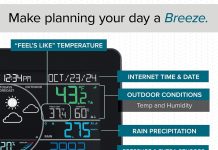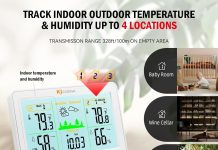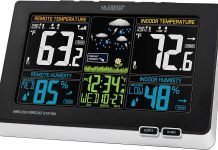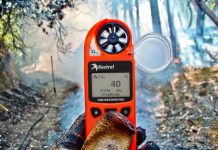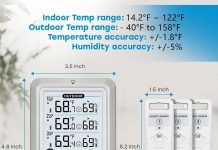Curiosity piqued, we find ourselves pondering the role of the hygrometer on a weather station. With its unassuming presence, this humble instrument quietly carries out an essential task: measuring the humidity of the surrounding air. We delve into the fascinating world of hygrometers and uncover their significance in providing valuable insights into atmospheric conditions. Join us as we unravel the mysteries behind this unassuming yet crucial device.
Review contents
Heading 1: Introduction
Welcome to our comprehensive guide on hygrometers! In this article, we will explore the fascinating world of hygrometers and their role in measuring humidity. Whether you are a weather enthusiast, a gardener, or simply curious about the weather conditions around you, understanding hygrometers and their significance can greatly enhance your knowledge and decision-making. So, let’s dive in and discover the ins and outs of these indispensable devices!
Heading 2: Overview of Weather Station
Before we delve into the specifics of hygrometers, let’s first familiarize ourselves with weather stations. A weather station is a collection of instruments that gather and record data about atmospheric conditions. It is equipped with various sensors to measure parameters like temperature, rainfall, wind speed, and humidity. These stations provide valuable information for meteorological purposes, agriculture, research, and everyday use.
Within a weather station, the hygrometer plays a crucial role in measuring humidity levels. Humidity refers to the amount of moisture present in the air, and it plays a significant role in weather patterns, comfort levels, and even the well-being of plants and animals. By using a hygrometer, we can accurately measure and monitor humidity, allowing us to make informed decisions and better understand our environment.
Heading 3: Definition of a Hygrometer
A hygrometer is a device used to measure the amount of moisture or humidity in the air. It enables us to determine the relative humidity present in our surroundings, giving us valuable insights into the current moisture levels. This information is vital for a wide range of applications, from weather forecasting to industrial processes and even health and safety precautions.
Heading 4: Types of Hygrometers
There are several types of hygrometers available, each utilizing different principles and mechanisms to measure humidity accurately. Let’s explore some of the most commonly used types:
-
Psychrometers: These hygrometers work on the principle of evaporative cooling. They consist of two thermometers, one wet-bulb, and one dry-bulb. By comparing the readings of the two thermometers, we can determine the relative humidity.
-
Hair Hygrometers: Hair hygrometers use human or animal hair as a humidity-sensitive element. When the hair absorbs moisture from the atmosphere, it expands or contracts, indicating the humidity level. They have been in use for centuries and are known for their accuracy and reliability.
-
Electrical Hygrometers: These hygrometers measure humidity using electrical resistance, capacitance, or potential difference. Capacitive hygrometers, for example, utilize changes in the electrical properties of a moisture-absorbing material to calculate humidity levels accurately.
-
Gravimetric Hygrometers: Gravimetric hygrometers measure humidity by weighing a sample of air before and after it comes into contact with a moisture-absorbing material. By measuring the weight difference, the humidity level can be determined accurately.
Heading 5: How Does a Hygrometer Work?
Now that we have an understanding of the different types of hygrometers, let’s explore how they work. Regardless of the specific mechanism employed, all hygrometers function with the same aim: to measure the moisture content in the air. Here is a simplified explanation of how a typical hygrometer operates:
-
Sensing Element: A hygrometer consists of a sensing element that reacts to changes in humidity. This element could be a strand of hair, a moisture-absorbing material, or an electrical component sensitive to moisture.
-
Measurement Mechanism: The sensing element undergoes a physical change when exposed to different humidity levels. This change might involve expansion or contraction, changes in electrical properties, or weight fluctuations.
-
Conversion and Display: The hygrometer converts the physical change in the sensing element into a measurable value, typically displayed as a percentage representing the relative humidity. Some hygrometers may also feature additional functions such as temperature measurement or trend indicators.
-
Calibration: It’s essential to calibrate a hygrometer periodically to ensure accurate readings. Calibration involves comparing the hygrometer’s measurements to a known reference point, making any necessary adjustments to align it with the correct humidity values.
Understanding the inner workings of a hygrometer allows us to appreciate the precision and reliability of these devices in measuring humidity levels accurately.
Heading 6: The Importance of Measuring Humidity
Measuring humidity is of utmost importance in various fields and daily life. Here are a few key reasons why understanding humidity levels is vital:
-
Weather Forecasting: Humidity plays a crucial role in weather patterns. By accurately measuring humidity levels, meteorologists can better predict phenomena such as rainfall, fog, or even severe weather conditions. This information is invaluable for planning outdoor activities, agricultural practices, and ensuring public safety.
-
Indoor Comfort: Maintaining optimal humidity levels indoors contributes to our overall comfort and well-being. Humidity that is too high can lead to a stuffy or clammy environment, while excessive dryness can cause respiratory discomfort, dry skin, and even static electricity. By using a hygrometer, we can adjust indoor conditions to achieve a balanced and comfortable atmosphere.
-
Health Considerations: Humidity can impact our health in several ways. Excessively dry air can cause respiratory issues, while high humidity levels can contribute to the growth of mold, dust mites, and other allergens. By monitoring and controlling humidity, we can create healthier living conditions and reduce the risk of respiratory problems, allergies, and other health concerns.
Heading 7: Factors Influencing Humidity
Humidity levels are influenced by various factors both indoors and outdoors. Here are some key factors that can affect humidity levels:
-
Temperature: Warm air can hold more moisture than cold air. As the temperature rises, the air’s capacity to hold water vapor increases, resulting in lower relative humidity. Conversely, as the temperature drops, the humidity level can increase even if the actual amount of moisture remains constant.
-
Proximity to Water: Humidity tends to be higher in locations near bodies of water such as oceans, lakes, or rivers. The increased presence of water leads to higher evaporation rates, subsequently increasing humidity levels in the surrounding air.
-
Time of Day: Humidity levels fluctuate throughout the day due to changing temperatures, solar radiation, and wind patterns. Generally, humidity is higher during the early morning and evening when temperatures are cooler and reaches its lowest point during the afternoon when temperatures peak.
-
Seasonal Changes: Seasonal variations also impact humidity levels. For example, areas experiencing monsoon seasons may have significantly higher humidity levels during those periods compared to the rest of the year.
-
Human Activities: Certain human activities, such as showering, cooking, or using humidifiers, can introduce additional moisture into the air, resulting in increased humidity levels indoors.
Understanding these influencing factors gives us a better grasp of the dynamic nature of humidity and its impact on our environment.
Heading 8: Applications of Hygrometers
Hygrometers have diverse applications across various industries and everyday life. Let’s take a look at some of the key uses of hygrometers:
-
Weather Monitoring: Meteorologists rely on hygrometers to accurately measure and monitor humidity as part of their weather forecasting and analysis. This data is crucial for predicting precipitation, cloud formation, and other weather patterns.
-
Agriculture and Gardening: Farmers, gardeners, and horticulturists use hygrometers to ensure optimal growing conditions for plants. By monitoring humidity levels, they can adjust irrigation schedules, greenhouse environments, and prevent plant diseases associated with excessive moisture.
-
Industrial Processes: Many industrial processes, such as food production, pharmaceuticals, and electronics manufacturing, require precise humidity control. Hygrometers enable careful monitoring and adjustment of humidity to ensure product quality, prevent spoilage, and maintain optimal manufacturing conditions.
-
Museums and Art Conservation: In museums and art galleries, maintaining the right humidity levels is crucial for preserving artifacts, paintings, and delicate artworks. Hygrometers play a vital role in monitoring and controlling humidity to prevent damage caused by excessive moisture or dryness.
-
Healthcare and Safety: In healthcare settings, hygrometers assist in maintaining appropriate humidity levels for patient comfort and preventing the spread of airborne infections. They are also crucial in laboratories, cleanrooms, and other controlled environments to ensure safe and sterile working conditions.
These are just a few examples of how hygrometers impact various industries and disciplines, underscoring their significance in maintaining optimal conditions and enhancing our quality of life.
Heading 9: Accuracy and Calibration of Hygrometers
To ensure accurate and reliable readings, it is crucial to periodically calibrate hygrometers. Calibration involves comparing the readings of a hygrometer to a known reference point to identify any deviations.
Calibration can be done using professional calibration equipment or by comparing the hygrometer’s readings to a trusted and accurate reference hygrometer. The calibration process allows for adjustments to be made to align the readings with the reference values, ensuring accurate measurements.
It is worth noting that different types of hygrometers may require different calibration procedures. Manufacturers typically provide guidelines and recommendations for calibration, and it is essential to follow their instructions for optimal accuracy.
Heading 10: Common Hygrometer Mistakes and Troubleshooting Tips
While hygrometers are reliable devices, errors can occur, leading to inaccurate measurements. Here are some common mistakes to avoid when using hygrometers, along with troubleshooting tips:
-
Incorrect Placement: Placing the hygrometer in unsuitable locations such as near a heat source, in direct sunlight, or in drafty areas can lead to inaccurate readings. Ensure proper placement away from direct sources of temperature or moisture influence.
-
Expired or Damaged Sensors: Over time, hygrometers’ sensors can deteriorate or become damaged, leading to inaccurate readings. Regularly check and replace sensors as necessary to maintain the device’s accuracy.
-
Lack of Calibration: Calibration is essential for accurate readings. Failure to calibrate hygrometers periodically can result in drift from the correct humidity values. Follow the manufacturer’s recommended calibration schedule and procedure to maintain accuracy.
-
Battery Issues: If your hygrometer is battery-powered, low battery levels can affect its performance and accuracy. Regularly check and replace batteries to ensure reliable readings.
-
Extreme Conditions: Some hygrometers may have limitations in extreme temperature or humidity ranges. Confirm the operational range of your device and avoid using it outside those parameters to prevent inaccurate readings.
By avoiding these common mistakes and following proper troubleshooting techniques, you can ensure the optimal performance of your hygrometer and obtain accurate humidity measurements.
In conclusion, hygrometers are indispensable tools for measuring and monitoring humidity levels. From weather forecasting to maintaining comfortable indoor environments and various industrial applications, hygrometers offer valuable insights into our surroundings. By understanding how hygrometers work, the factors influencing humidity, and their applications, we can make better informed decisions and improve our overall understanding of the world around us. So next time you come across a hygrometer, you’ll know just how important it is in helping us navigate our daily lives.


